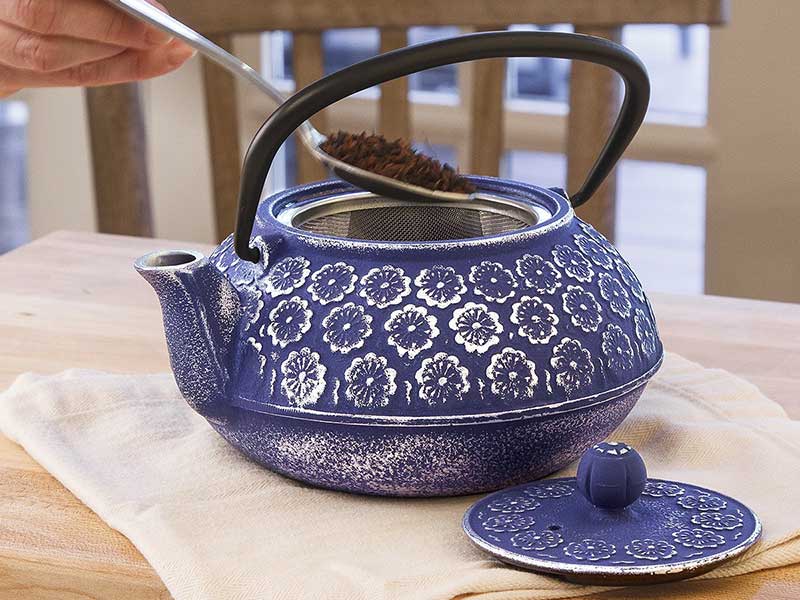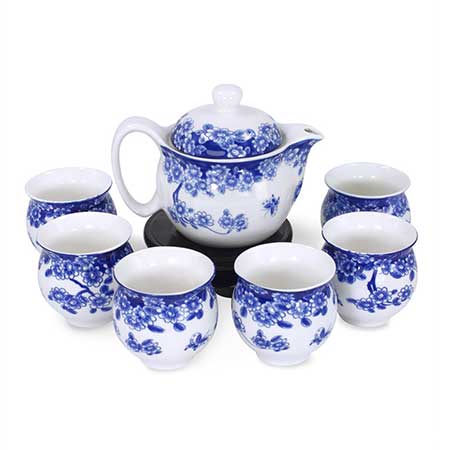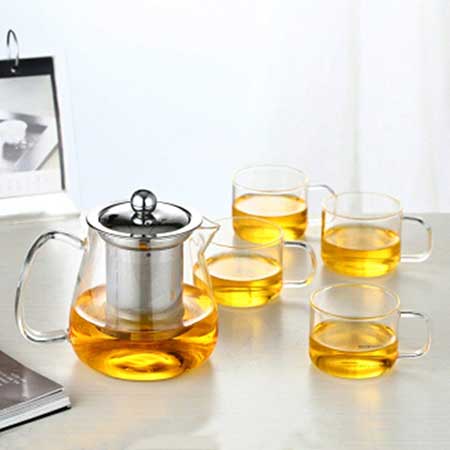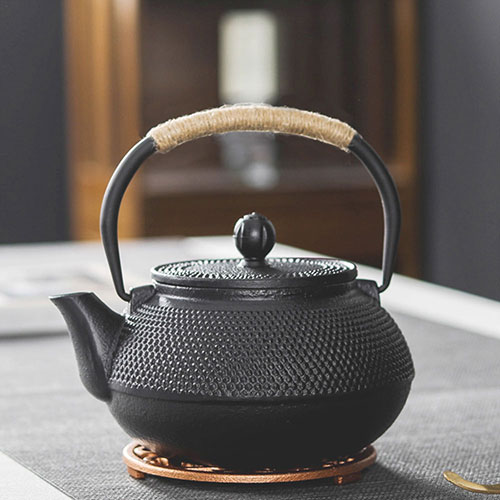How To Brew Tea In A Tetsubin

The handsome, hefty tetsubin. Is it a teapot? Is it a water kettle? Can it help heat your house? Is it best kept on the shelf? First things first: the name tetsubin is used, unfortunately interchangeably, to refer both to a cast iron pot used as a water-boiling kettle, and to a small cast iron pot used strictly to brew tea. As tetsubin have drifted into Western culture, the names and meanings of these pots have come to blur together (and indeed, there are some tea-brewing pots built to place over a heat source to boil as well, which adds to the confusion.)
A descendant of ancient Japanese water kettles, tetsubin came along with the growth in popularity of whole-leaf tea ceremony in Japan, in the seventeenth and eighteenth centuries. As tea drinking moved slowly to Japan from China, teawares originally Chinese in ancestry (and part of more high-society rituals) began to be replaced by humbler Japanese vessels, like the decorative but functional tetsubin. Formed in cast iron with a built-in handle, the first kettle-style tetsubin were heavy pots meant to be heated directly over a charcoal fire.
Contemporary tetsubin teapots inspired by these kettles, made only for brewing tea and not boiling water, are coated with enamel on the inside (to prevent rusting), making them unsuitable for stovetop or charcoal fire use. Highly designed tetsubin can be expensive, and serve as status symbols better suited for display than teamaking. Smaller, practical models are easily found, and are a pretty addition to any tea brewing collection.
Though the temptation to place your modern-day tetsubin teapot (and you'll know, by its size, enameled inside, and presence of a tea-strainer basket, whether it's intended as a tea brewer) on the stove is natural, most agree that it's best to heat water in a separate source, and then use the tetsubin only as a teapot. You'll still enjoy the even heating of cast iron, the decorative beauty of the pot, and perhaps if you're lucky a little added iron in your diet.
Varieties Of High Quality Tetsubin/Cast Iron Teapot/Japanese Tea Kettle
How to Brew in a Tetsubin Teapot
1. Select your tea Though most contemporary tetsubin teapots are enamel-coated on the inside, a patina can still develop over time depending on the type of tea you are using. For this reason, you'll want to select only one kind of tea (say, green, or lightly-oxidized oolongs) to use over and over again in your pot, as you would with other slightly porous teapots. Pick something you like—and stick to it!
2. Preheat and rinse Since you are working with cast iron, preheating your pot is an essential step. Boil water using an alternate source, and fill and rinse your teapot once or twice with the hot water. This both begins to warm up the teapot and rinses it clean—due to the tetsubin's shape, it can sometimes be hard to see how clean it is.
3. Measure your tea Tetsubin teapots come in a range of sizes, so you'll want to measure your tea proportionally to how much water you intend to use. Start with somewhere around 1 teaspoon of tea per 8 ounces of water, and adjust the quantity of your tea to taste as you learn about your teapot.
If your pot comes with a built-in strainer basket, you may prefer to brew smaller quantities of tea at a time, so as to not overpack the strainer and allow for optimum leaf expansion. Place the tea in the strainer and set into the tetsubin, or if there is no strainer, spoon it into the pot itself.
4. Heat your water and steep Heat water in a separate kettle, and when it's reached the right temperature for the tea you've selected, pour the measured amount of water over the leaves and steep (for green tea, for instance, steep about 2 minutes at 175° to 185° F).
5. Serve and clean up Now that your tea is ready, make sure to decant it all from the tetsubin pot at once so that it does not overextract. If your tetsubin does not have a built-in strainer, you'll need to pour the liquid off through a secondary strainer.
After you've finished as many infusions as you like, take great care to rinse out (use warm water so as not to crack the cast iron) and then dry your pot thoroughly (including lid and strainer basket) to prevent any rust anywhere on the pot. Never use soap.
With good care and attention, your tetsubin teapot will be a long-lasting, functional piece of art!



9 Comment(s)
Trò chơi trên FB88 rất dễ chơi, quy tắc rõ ràng và dễ hiểu.\r\nTôi cảm thấy rất an toàn khi chơi tại FB88, họ có các biện pháp bảo mật rất nghiêm ngặt.\r\nTôi rất thích trải nghiệm các trò chơi slot tại FB88, phần thưởng rất lớn và hấp dẫn.
Tôi rất yêu thích các trò chơi casino trực tuyến của FB88, chúng rất chân thực và thú vị.\r\nFB88 cung cấp các chương trình khuyến mãi rất hấp dẫn, người chơi có cơ hội nhận giải thưởng lớn.\r\nDịch vụ khách hàng trực tuyến rất tốt, thái độ phục vụ nhanh chóng và thân thiện.
Trường Tiểu học Nguyễn Trung Trực được thành lập năm 1985 có địa chỉ tại 9A Phạm Hồng Thái, phường Nguyễn Trung Trực, quận Ba Đình, Hà Nội (Nay thành phường Trúc Bạch). Trường hoạt động dưới sự quản lý của UBND quận Ba Đình và Phòng Giáo dục và Đào tạo Ba Đình. Trường được xây dựng khang trang trên diện tích hơn 3000 m2 với đủ các phòng học và phòng chức năng cho các hoạt động học tập, vui chơi, giải trí của học sinh.\r\nĐịa chỉ: Số 9A Phạm Hồng Thái - Ba Đình - Hà Nội\r\nEmail: [email protected]\r\nwebsite: https://c1nguyentrungtruc.badinh.edu.vn/\r\nĐiện thoại: 438261441
Trường Tiểu học Nguyễn Trung Trực được thành lập năm 1985 có địa chỉ tại 9A Phạm Hồng Thái, phường Nguyễn Trung Trực, quận Ba Đình, Hà Nội (Nay thành phường Trúc Bạch). Trường hoạt động dưới sự quản lý của UBND quận Ba Đình và Phòng Giáo dục và Đào tạo Ba Đình. Trường được xây dựng khang trang trên diện tích hơn 3000 m2 với đủ các phòng học và phòng chức năng cho các hoạt động học tập, vui chơi, giải trí của học sinh.\r\nĐịa chỉ: Số 9A Phạm Hồng Thái - Ba Đình - Hà Nội\r\nEmail: [email protected]\r\nwebsite: Https://kumu.io/NhacaiFB88betB88S/nhacaifb88betb88s#nhacaifb88betb88s\r\nĐiện thoại: 438261441
Trường Tiểu học Nguyễn Trung Trực được thành lập năm 1985 có địa chỉ tại 9A Phạm Hồng Thái, phường Nguyễn Trung Trực, quận Ba Đình, Hà Nội (Nay thành phường Trúc Bạch). Trường hoạt động dưới sự quản lý của UBND quận Ba Đình và Phòng Giáo dục và Đào tạo Ba Đình. Trường được xây dựng khang trang trên diện tích hơn 3000 m2 với đủ các phòng học và phòng chức năng cho các hoạt động học tập, vui chơi, giải trí của học sinh.\r\nĐịa chỉ: Số 9A Phạm Hồng Thái - Ba Đình - Hà Nội\r\nEmail: [email protected]\r\nwebsite: Https://kumu.io/NhacaiFB88betB88S/nhacaifb88betb88s#nhacaifb88betb88s\r\nĐiện thoại: 438261441
Trường Tiểu học Nguyễn Trung Trực được thành lập năm 1985 có địa chỉ tại 9A Phạm Hồng Thái, phường Nguyễn Trung Trực, quận Ba Đình, Hà Nội (Nay thành phường Trúc Bạch). Trường hoạt động dưới sự quản lý của UBND quận Ba Đình và Phòng Giáo dục và Đào tạo Ba Đình. Trường được xây dựng khang trang trên diện tích hơn 3000 m2 với đủ các phòng học và phòng chức năng cho các hoạt động học tập, vui chơi, giải trí của học sinh.\r\nĐịa chỉ: Số 9A Phạm Hồng Thái - Ba Đình - Hà Nội\r\nEmail: [email protected]\r\nwebsite: Https://s666s666s.com/\r\nĐiện thoại: 438261441
Trường Tiểu học Nguyễn Trung Trực được thành lập năm 1985 có địa chỉ tại 9A Phạm Hồng Thái, phường Nguyễn Trung Trực, quận Ba Đình, Hà Nội (Nay thành phường Trúc Bạch). Trường hoạt động dưới sự quản lý của UBND quận Ba Đình và Phòng Giáo dục và Đào tạo Ba Đình. Trường được xây dựng khang trang trên diện tích hơn 3000 m2 với đủ các phòng học và phòng chức năng cho các hoạt động học tập, vui chơi, giải trí của học sinh.\r\nĐịa chỉ: Số 9A Phạm Hồng Thái - Ba Đình - Hà Nội\r\nEmail: [email protected]\r\nwebsite: Https://s666s666s.com/\r\nĐiện thoại: 438261441
Trường Tiểu học Nguyễn Trung Trực được thành lập năm 1985 có địa chỉ tại 9A Phạm Hồng Thái, phường Nguyễn Trung Trực, quận Ba Đình, Hà Nội (Nay thành phường Trúc Bạch). Trường hoạt động dưới sự quản lý của UBND quận Ba Đình và Phòng Giáo dục và Đào tạo Ba Đình. Trường được xây dựng khang trang trên diện tích hơn 3000 m2 với đủ các phòng học và phòng chức năng cho các hoạt động học tập, vui chơi, giải trí của học sinh.\r\nĐịa chỉ: Số 9A Phạm Hồng Thái - Ba Đình - Hà Nội\r\nEmail: [email protected]\r\nwebsite: Https://s666s666s.com/\r\nĐiện thoại: 438261441
Trường Tiểu học Nguyễn Trung Trực được thành lập năm 1985 có địa chỉ tại 9A Phạm Hồng Thái, phường Nguyễn Trung Trực, quận Ba Đình, Hà Nội (Nay thành phường Trúc Bạch). Trường hoạt động dưới sự quản lý của UBND quận Ba Đình và Phòng Giáo dục và Đào tạo Ba Đình. Trường được xây dựng khang trang trên diện tích hơn 3000 m2 với đủ các phòng học và phòng chức năng cho các hoạt động học tập, vui chơi, giải trí của học sinh.\r\nĐịa chỉ: Số 9A Phạm Hồng Thái - Ba Đình - Hà Nội\r\nEmail: [email protected]\r\nwebsite: Https://s666s666s.com/\r\nĐiện thoại: 438261441
Leave a Comment